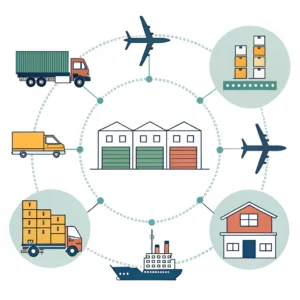Negotiating better rates with air cargo carriers starts by understanding market dynamics, preparing comprehensive data, and leveraging strategic negotiation tactics to secure competitive pricing. In this article, we break down the key challenges, explain the underlying causes, and provide actionable solutions for logistics and procurement managers looking to reduce their air freight costs.
Air cargo pricing is influenced by several factors such as fuel costs, capacity constraints, seasonal demand, and geopolitical events. These dynamics result in volatile pricing structures and sometimes hidden charges. Supply chain professionals need to be well-informed about these factors to gain leverage during negotiations with carriers.
- Dynamic Pricing: Air cargo rates can fluctuate rapidly, making it hard to predict costs.
- Additional Fees: Carriers may include accessorial charges1, fuel surcharge adjustments, and other fees that complicate the final cost.
- Volume and Consolidation: Negotiating charges for small shipments might not yield the same discounts as larger consolidated loads.
- Limited Transparency: Hidden surcharges and variable pricing models may obscure true cost structures.
- Competitive Market: With multiple carriers available, negotiating rates requires understanding market spot rates and industry trends.
These challenges emphasize the need for a structured approach to negotiation that explores every avenue of cost optimization.
Before entering negotiation discussions, it’s important to analyze the reasons behind current pricing levels:
- Spot Rate Fluctuations: Market conditions and sudden shifts in supply and demand can drive up spot rates2 unexpectedly.
- Load-to-Truck Ratio3: Lower ratios during off-peak seasons may give you leverage by indicating low demand.
- Cost Metrics: Metrics such as cost per mile and cargo weight directly influence carrier pricing. A clear understanding of these metrics is vital.
- Operational Constraints: Factors like load times, dock hours, and lane fees can add complexity to pricing structures.
- Volume vs. Frequency: Frequent small shipments tend to lead to less favorable pricing compared to consolidated shipments.
To effectively negotiate air cargo rates, consider the following strategic steps:
Collecting detailed, real-time data is the foundation of effective negotiation. This involves:
- Comparing spot rates2 and historical pricing trends.
- Calculating key metrics (e.g., cost per kg and cost per mile).
- Reviewing fuel surcharge trends, accessorial charges, and any hidden fee structures.
Knowing your shipment profiles helps in bargaining more effectively:
- Shipment Size: Consolidate multiple small shipments into bigger volumes to negotiate volume discounts.
- Frequency and Regularity: Commit to regular shipping schedules to secure long-term contracts with guaranteed lower rates.
- Service Level Requirements: Determine if you can compromise on time performance for cost savings, or if premium service is essential.
Craft a clear strategy by considering the following:
- Set Clear Objectives: Understand your target rate and maximum acceptable cost.
- Leverage Multiple Carriers: Open bids to multiple carriers to stimulate competitive pricing.
- Utilize Volume Discounts: Bundle shipments where possible. This creates a case for airlines to offer discounts based on economies of scale.
- Long-term Partnerships: Establish long-term contracts in exchange for better pricing terms and priority service allocation.
Before entering negotiations, preparing a detailed proposal presentation including:
- A summary of your historical shipment data.
- Forecasted shipment volumes.
- Potential cost savings projections via consolidation or volume bundling.
- Competitive offers you’ve received from alternative carriers.
Below is an example table for comparing pricing proposals:
| Factor | Carrier A | Carrier B | Your Target |
|---|---|---|---|
| Base Rate (USD/kg) | $7.00 | $6.50 | $6.00 |
| Fuel Surcharge (%) | 12% | 10% | ≤10% |
| Accessorial Charges | $150 per shipment | $100 per shipment | ≤$100 |
| Contract Duration | 1 Year | 2 Years | Flexible |
| Volume Discounts | Available | Not available | Requested |
This table not only helps in comparing offers but also in clearly communicating your expectations to carriers.
Stay updated with the latest air cargo market trends4. Being informed about current challenges and ahead-of-trend data can significantly boost your negotiation position:
- Monitor fuel price fluctuations and adjust your negotiation terms accordingly.
- Understand seasonal demand and capacity constraints which might favor you during low-demand periods.
- Use industry reports and market forecasts to validate your cost-saving proposals.
Sometimes in-house expertise may not be enough. Hiring seasoned freight negotiators or supply chain consultants with specialized knowledge in cargo carrier contracts5 can add significant value. They can provide:
- Advanced market analytics.
- Negotiation frameworks based on best practices.
- Expert advice on crafting compelling proposals.
Negotiations also include handling risks and hidden costs:
- Review Contract Fine Print: Ensure that all potential fees and surcharges are transparently detailed.
- Flexibility Clauses: Negotiate clauses that allow adjustments when market conditions change.
- Performance Metrics: Include performance-based clauses to incentivize carriers to maintain service quality while adhering to cost targets.
After contracts are signed, monitoring remains essential:
- Implement a tracking system for shipping cost reduction and operational efficiencies.
- Regularly review billing statements for any discrepancies or unexpected charges.
- Maintain continuous communication with carriers to address and resolve any issues promptly.
A mid-sized manufacturing company faced rising air cargo costs due to fluctuating fuel surcharges and decreasing load-to-truck ratios. By taking the following steps, they managed to reduce shipping expenses by 15%:
- The company initiated rigorous data collection, compiling monthly shipment volumes, rate trends, and fuel surcharge impacts.
- They consolidated smaller shipments into larger batches, which allowed for volume discount negotiations.
- Multiple carriers were invited to tender proposals, leading to competitive quotes.
- The company negotiated a long-term contract with clear clauses for performance and flexible adjustments based on market trends.
- Regular reviews of the billing process ensured that all charges matched the agreed terms.
The result was not only a reduction in air freight costs but also improved service reliability and enhanced negotiation capabilities for future contracts.
In summary, to negotiate better rates with air cargo carriers:
- Acquire and analyze detailed data on shipment profiles and historical pricing.
- Know your shipment volume and frequency, and leverage consolidation opportunities.
- Engage multiple carriers in competitive bidding and establish long-term partnerships.
- Develop a comprehensive negotiation strategy that includes risk management and contract flexibility.
- Continuously monitor contract performance and market trends to ensure optimal cost control over time.
Implement these strategies to maintain competitive air freight rates and enhance the overall efficiency and cost-effectiveness of your supply chain. By being prepared and proactive, logistics and procurement managers can turn negotiations into a strategic advantage for their companies.
Q: How to negotiate better freight rates?
A: To negotiate better freight rates, start by gathering accurate data on spot rates, workload, and historical pricing. Leverage volume discounts by consolidating shipments and consider collaborating with multiple carriers to create competition. Make sure to clarify all extra fees and negotiate long-term contracts that lock in favorable rates.
Q: How can I make air freight cheaper?
A: One key approach to lower air freight costs is to consolidate multiple small shipments into one larger load. This allows you to benefit from economies of scale, which can significantly reduce the overall cost and secure volume discounts from airlines.
Q: How does air cargo pricing work?
A: Air cargo pricing typically depends on the weight of the cargo multiplied by a freight cost per kg or pound. Additional elements such as fuel surcharges, accessorial charges, and operational fees are also factored in, making it essential to fully understand all components of the pricing model for accurate cost management.
-
accessorial charges: Click here to explore the various additional fees that can be included in shipping costs and strategies to mitigate their impact. ↩ ↩
-
spot rates: Click here to learn how real-time pricing fluctuations impact shipping costs and strategies for leveraging these rates to optimize freight negotiations. ↩ ↩ ↩2
-
Load-to-Truck Ratio: Click here to understand how the load-to-truck ratio affects capacity, pricing dynamics, and negotiation leverage in transportation logistics. ↩ ↩
-
air cargo market trends: Click here to delve into current market trends affecting air cargo, including seasonal patterns, fuel price changes, and capacity shifts, to improve strategic planning. ↩ ↩
-
cargo carrier contracts: Click here to learn about the critical elements and negotiation tactics involved in drafting effective cargo carrier contracts. ↩ ↩












